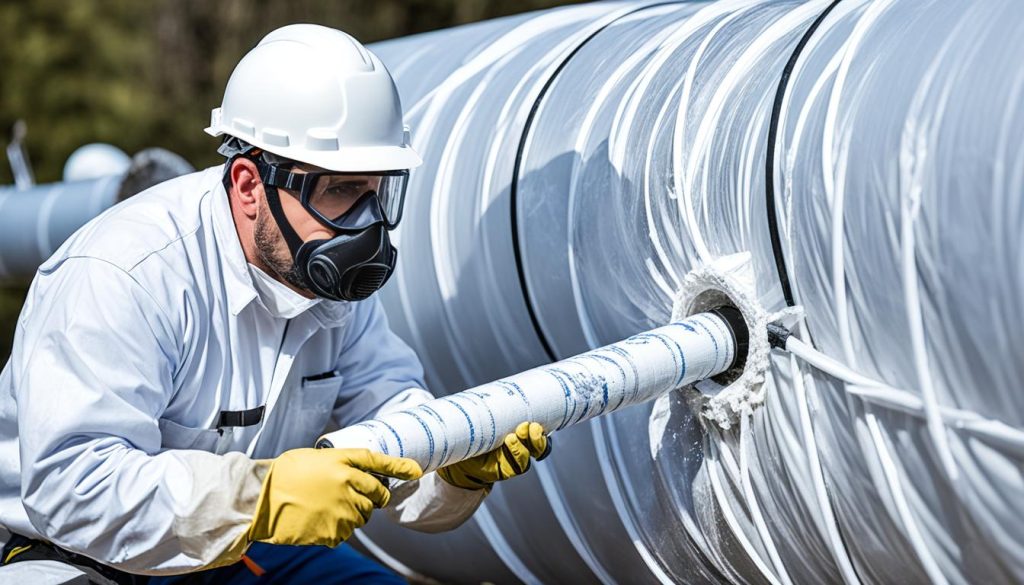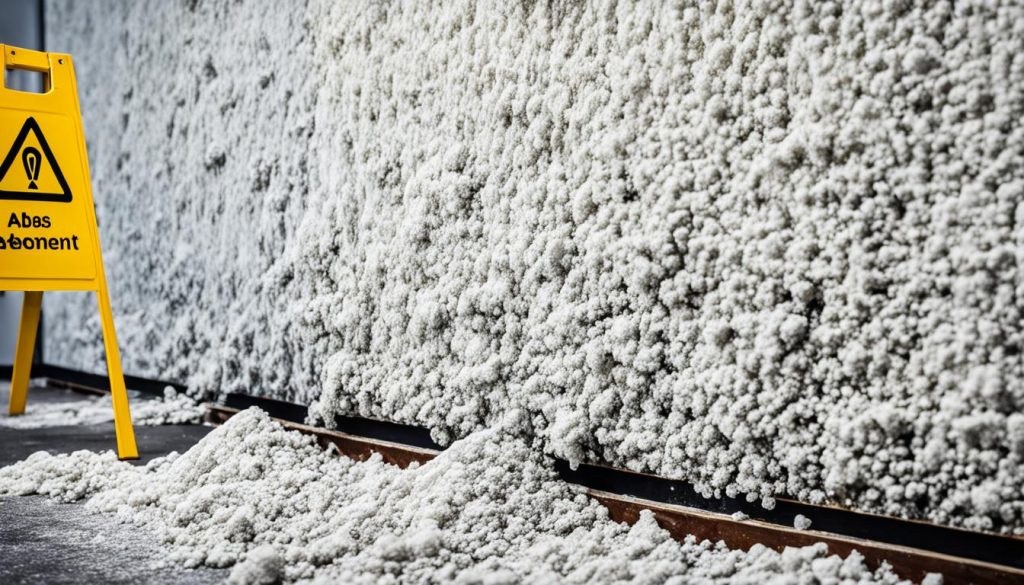Encapsulate Asbestos Pipes: Safe & Effective
Did you know that asbestos-containing materials were widely used in buildings across Canada until the late 1980s? This means that many older buildings still have asbestos pipes, which can pose a significant health risk if not properly managed.
Asbestos is a highly hazardous substance that, when disturbed, releases microscopic fibers into the air. Inhalation of these fibers can lead to serious respiratory illnesses, including lung cancer and mesothelioma. That’s why it’s crucial to take proactive measures to encapsulate asbestos pipes and ensure the safety of occupants and workers.
Key Takeaways:
- Asbestos-containing materials (ACMs) were widely used in buildings in Canada until the late 1980s.
- Asbestos pipe insulation can release hazardous fibers if not properly managed.
- Encapsulating asbestos pipes creates a barrier that conceals and prevents the release of asbestos fibers.
- Proper encapsulation involves safety measures, repairing damaged insulation, wrapping with lagging, and sealing with an encapsulant.
- Encapsulation is a cost-effective and minimally disruptive solution for managing asbestos-containing pipes.
Understanding Asbestos Encapsulation
Asbestos encapsulation is a process that involves covering or enclosing asbestos-containing materials (ACMs) with a protective coating or material to prevent the release of asbestos fibers into the air. This method creates a barrier that seals off the asbestos, reducing the risk of exposure.
The process typically includes the following steps:
- Thorough assessment and survey of the ACMs
- Preparation of the area to be encapsulated
- Cleaning and repairing of the ACMs
- Application of a specialized encapsulation material
- Inspection and testing of the encapsulated ACMs
- Ongoing monitoring and maintenance
Asbestos encapsulation is a cost-effective and minimally disruptive solution for managing ACMs, especially in situations where removal is not feasible or desirable. By encapsulating asbestos materials, the risk of fiber release is significantly reduced, ensuring the safety of occupants and workers.
Benefits of Asbestos Encapsulation
There are several benefits to choosing asbestos encapsulation as a method of asbestos management:
- Cost-effectiveness: Asbestos encapsulation is often more affordable than complete removal, as it eliminates the need for extensive demolition and disposal procedures.
- Preservation of architectural features: Encapsulation allows historic structures with asbestos-containing materials to retain their original design and finishes.
- Minimized disruption: Unlike asbestos removal, which can be highly disruptive, encapsulation allows ACMs to remain in place, reducing the need for relocation or temporary closures.
- Long-term solution: The protective barrier created by encapsulation materials stabilizes the asbestos, providing a long-term solution for managing ACMs.
It is crucial to hire asbestos encapsulation specialists who are trained and certified to ensure the process is done safely and effectively. These professionals have the knowledge and expertise to assess the specific requirements of your property, choose the appropriate encapsulation materials, and perform the necessary inspections and maintenance.
Next, we will explore the key differences between asbestos abatement and encapsulation, helping you make an informed decision on the best approach for managing asbestos in your property.
Benefits of Asbestos Encapsulation
Asbestos encapsulation provides numerous advantages when it comes to managing asbestos-containing materials (ACMs). Compared to asbestos removal or abatement, encapsulation offers a cost-effective solution that eliminates the need for expensive removal procedures and disposal. This makes it an attractive option for property owners looking to manage asbestos while minimizing costs.
One of the key benefits of asbestos encapsulation is that it allows ACMs to remain in place, reducing disruption to building occupants and operations. This is particularly advantageous in situations where removing asbestos is not feasible or desirable. By encapsulating the asbestos, the risk of exposure to harmful asbestos fibers is significantly reduced while preserving the integrity of the building structure.
Another advantage of asbestos encapsulation is its suitability for historic structures that contain asbestos. By encapsulating the ACMs, the original architectural features and finishes can be retained, ensuring the preservation of the building’s unique character. This is especially important in heritage buildings, where maintaining the historical authenticity is paramount.
Furthermore, encapsulation provides a long-term solution for managing ACMs. The protective barrier created by the encapsulation material effectively stabilizes the asbestos, drastically reducing the risk of fiber release. This ensures the safety of occupants and mitigates potential health hazards associated with asbestos exposure.
Complying with regulatory requirements for asbestos encapsulation is crucial to ensure the safety and well-being of everyone involved. By adhering to these regulations, property owners can confidently manage ACMs and create a safe environment.
To further illustrate the benefits of asbestos encapsulation, here is a table comparing the key advantages of encapsulation, asbestos abatement, and asbestos removal:
| Asbestos Encapsulation | Asbestos Abatement | Asbestos Removal | |
|---|---|---|---|
| Cost-effective | Yes | No | No |
| Minimal disruption to occupants | Yes | No | No |
| Preserves building features | Yes | No | No |
| Long-term solution | Yes | No | No |
| Reduces risk of fiber release | Yes | No | No |
As seen in the table, asbestos encapsulation excels in cost-effectiveness, minimal disruption to occupants, preservation of building features, long-term solution capability, and reducing the risk of fiber release compared to asbestos abatement and removal.
Therefore, property owners should seriously consider asbestos encapsulation as a viable solution for managing ACMs, taking into account the unique requirements and characteristics of their specific building or structure.
Regulatory Compliance for Asbestos Encapsulation
Asbestos encapsulation is subject to strict regulatory requirements to ensure the proper handling and management of asbestos-containing materials (ACMs). In Canada, the specific regulations for asbestos management may vary by province or territory. It is essential to hire certified asbestos encapsulation specialists who are knowledgeable about the local regulations and can ensure compliance.
When hiring asbestos encapsulation specialists, they will conduct a thorough assessment and survey of the ACMs to determine the best approach for encapsulation. They will also prepare the area properly, ensuring that all necessary safety measures are in place. This may include isolating the work area with plastic sheeting, implementing proper ventilation, and establishing a decontamination area.
The encapsulation specialists will then apply the appropriate encapsulation materials to the ACMs, creating a protective barrier that seals off the asbestos fibers. These materials may include encapsulating coatings, paints, or adhesives specifically designed for ACMs.
After the encapsulation is complete, the specialists will conduct inspections and testing to verify the effectiveness of the encapsulation. This may involve air monitoring and sample analysis to ensure that there is no release of asbestos fibers.
It is important to note that if encapsulated asbestos needs to be removed in the future, it should only be done by qualified and licensed asbestos removal contractors who follow proper procedures and regulatory requirements. These contractors have the expertise and equipment necessary to safely remove encapsulated asbestos without causing contamination or releasing fibers into the air.
By ensuring regulatory compliance for asbestos encapsulation, you can have peace of mind knowing that the process is being carried out safely and effectively, reducing the risk of exposure to hazardous asbestos fibers.
Asbestos Abatement vs. Asbestos Encapsulation
When it comes to managing asbestos-containing materials (ACMs), property owners need to weigh the pros and cons of asbestos abatement and asbestos encapsulation. Both methods have their advantages and considerations, making it essential to evaluate the specific needs of the building or structure.
Asbestos abatement, also known as asbestos removal, involves completely eliminating ACMs from the premises. This process is time-consuming, costly, and eliminates the need to deal with asbestos in the future. However, it can be disruptive and may require temporary relocation of occupants.
On the other hand, asbestos encapsulation offers a more cost-effective and less invasive solution. This method involves covering or enclosing ACMs with a protective barrier, reducing the risk of exposure to asbestos fibers. Encapsulation allows the ACMs to remain in place, minimizing disruption to building occupants and operations.
While encapsulation is a practical and long-term solution, it requires ongoing monitoring and maintenance to ensure the effectiveness of the protective barrier. If remodeling or demolition is planned in the future, the encapsulation may need to be removed to accommodate the changes.
Choosing between asbestos abatement and encapsulation depends on several factors. The duration of ownership, future remodeling plans, and the specific needs of the building or structure should all be taken into account. Consulting with asbestos professionals can help property owners make an informed decision.
Considerations when Choosing Between Abatement and Encapsulation:
- Duration of ownership
- Future plans for the property
- Budget and cost considerations
- Level of disruption to occupants
- Regulatory compliance requirements
By carefully considering these factors and working with experienced asbestos professionals, property owners can make the right choice regarding asbestos management. Whether it’s asbestos abatement or encapsulation, prioritizing safety and compliance will ensure the well-being of occupants and the long-term integrity of the building.
Factors to Consider When Choosing Between Abatement and Encapsulation
When faced with the decision of asbestos management, it’s essential to consider various factors to make an informed choice between asbestos removal or encapsulation. I understand that this can be a significant decision, and I’m here to provide guidance. Let’s explore some crucial factors to help you make an informed decision:
1. Future Property Sale
If you plan to sell the property in the near future, it’s essential to note that many potential buyers may be hesitant to purchase a property with encapsulated asbestos. In such cases, asbestos removal may be a more favorable option. Removing asbestos ensures that potential buyers have peace of mind regarding the hazardous material.
2. Hidden Costs
Consider the hidden costs associated with each option. If you choose asbestos removal, you may need to re-insulate pipes or ductwork once the asbestos insulation is removed. Ensure you factor in these additional costs to make an accurate comparison between the two options.
3. Remodeling or Demolition Plans
If you have plans for remodeling or demolition that will disturb the encapsulated asbestos, asbestos removal may be the better choice. Disrupting the encapsulation can compromise its effectiveness and pose a potential risk. Thus, removing it entirely will eliminate any concerns when conducting remodeling or demolition projects.
4. Consultation with Asbestos Removal Contractors
To make an informed decision, consult with reputable asbestos removal contractors. They will assess the specific requirements and costs associated with both asbestos removal and encapsulation for your property. Additionally, they will ensure that the work complies with all necessary regulations.
By carefully considering these factors and seeking guidance from asbestos removal contractors, you can confidently choose between asbestos removal or encapsulation, aligning with your property’s specific needs and regulatory requirements.
| Factors to Consider | Asbestos Removal | Asbestos Encapsulation |
|---|---|---|
| Potential buyer concerns | Eliminates concerns | Potential buyer hesitations |
| Hidden costs | Costly re-insulation | Minimal additional costs |
| Remodeling or demolition | No disruption | Potential disruption |
| Property-specific assessment | Consultation required | Consultation required |
Final Considerations
When it comes to managing asbestos-containing materials (ACMs) in your property, prioritizing safety and compliance with regulations is paramount. Whether you choose asbestos abatement, encapsulation, or removal, it is crucial to make an informed decision that aligns with your specific needs and circumstances.
Working with certified professionals who specialize in asbestos abatement and encapsulation is essential. These experts will thoroughly assess the condition of your property and provide detailed cost estimates for each option. They have the knowledge and experience to ensure that the work is done safely and effectively, adhering to all regulatory requirements.
It is important to note that encapsulated asbestos requires ongoing monitoring and maintenance to remain effective. Regular inspections should be conducted to ensure the integrity of the encapsulation and to address any potential issues promptly. By staying proactive in the management of ACMs, you can minimize the risk of fiber release and ensure the long-term safety of your property.
In conclusion, whether you opt for asbestos abatement, encapsulation, or removal, the focus should be on safeguarding the health and well-being of everyone involved. By making an informed decision and working with reputable professionals, you can effectively manage the presence of asbestos in your property and create a safe and secure environment for years to come.
Source Links
- https://www.buyinsulationproductstore.com/blog/the-four-steps-to-asbestos-pipe-insulation-encapsulation/
- https://www.rbasbestos.co.uk/asbestos-encapsulation-ultimate-guide/
- https://dirtyductscleaning.com/blog.php?p=asbestos-abatement-or-asbestos-encapsulation
- Investing Wisely: How Windows & Doors in Boost Property Value and Financial Health - April 24, 2025
- The Financial Impact of Personal Injuries: Why Legal Help Matters for Business Owners - April 16, 2025
- The Hidden Financial Costs of Domestic Assault: What Business Owners Need to Know - April 16, 2025














